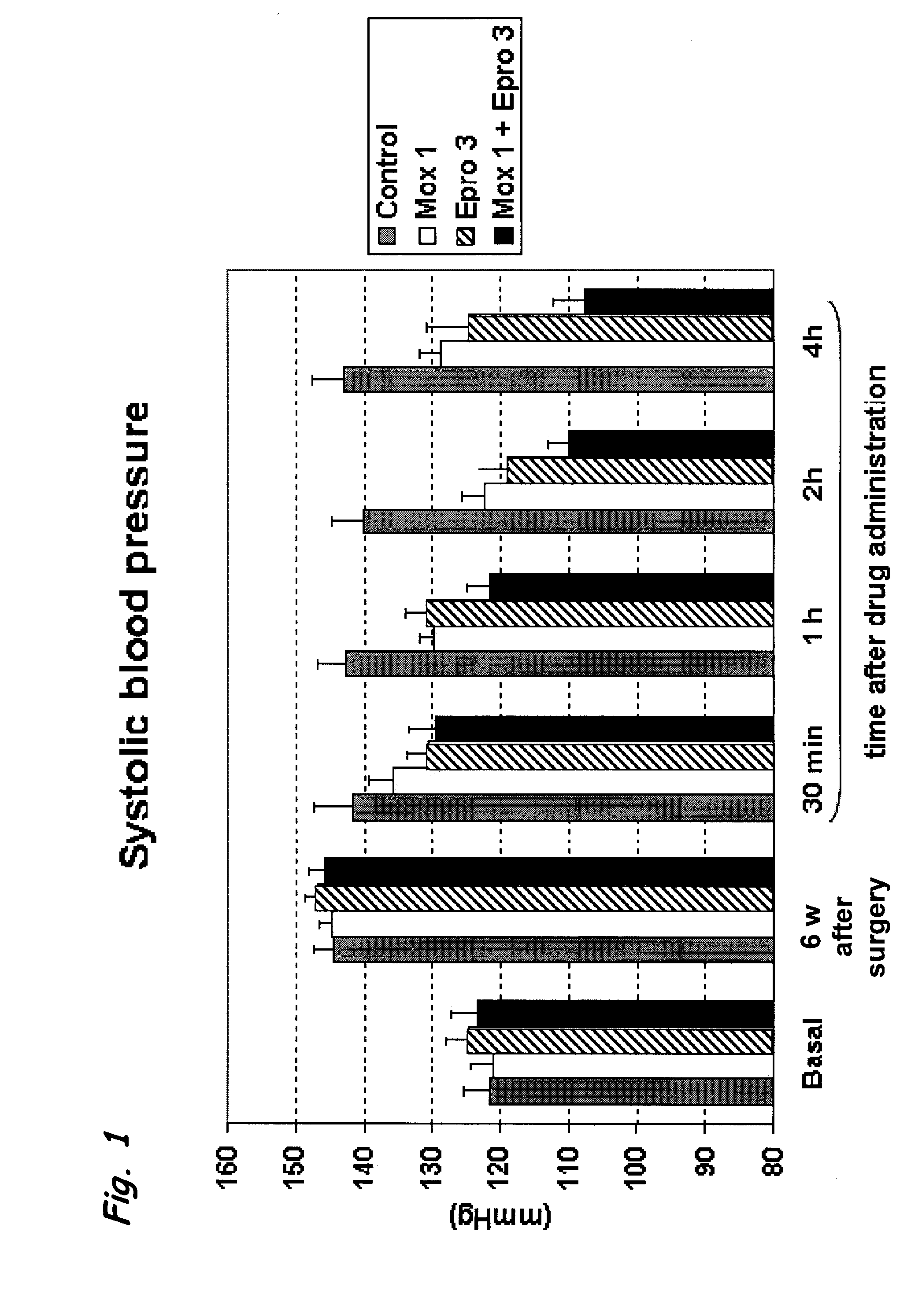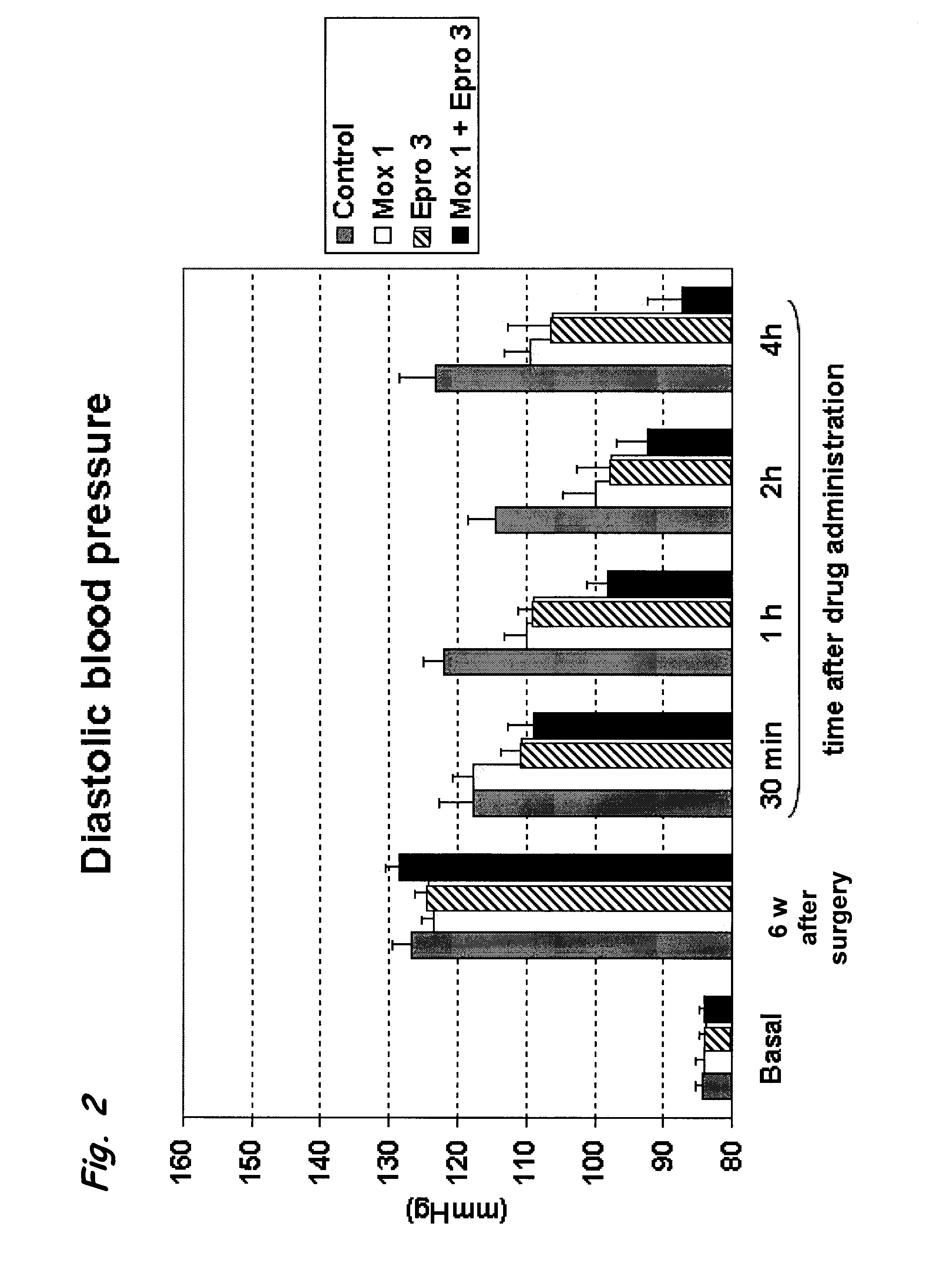Pharmaceutical Compositions Comprising a Selective I1 Imidazoline Receptor Agonist and an Angiotensin II Receptor Blocker
a technology of imidazoline receptor and selective i1 imidazoline, which is applied in the direction of drug compositions, metabolism disorders, extracellular fluid disorders, etc., can solve the problems of rarely achieving clinical practice targets by one single drug, and generally poorly controlled systolic blood pressure, so as to reduce the blood pressure level and improve the effect of systolic blood pressur
- Summary
- Abstract
- Description
- Claims
- Application Information
AI Technical Summary
Benefits of technology
Problems solved by technology
Method used
Image
Examples
example 1
[0117]A tablet formulation was produced by a high shear Fielder granulation. The purified water is added during granulation to form the dihydrate of the Eprosartan salt. The film coat is applied to a level of approximately 2.5-4% of core weight.
AmountsIngredients(& w / w)IntragranularEprosartan mesylate (400 mg as zwitterion)61.32Lactose, Monohydrate (Impalpable) NF3.59Microcrystalline Cellulose (Avicel PH102) NF3.59Pregelatinized starch (Starch 1551) USP3.59Purified water USP4.36ExtragranularCroscarmellose sodium (Ac-Di-Sol)4.00Microcrystalline cellulose (Avicel PH102) NF18.74Moxonidine (0.4 mg)0.06Magnesium stearate0.75Tablet core weight100Film coating: Opadry Blue OY-S-20900
example 2
Pharmacological Assay for Hypertension
1. Introduction
[0118]The effect of a combined administration of moxonidine, as an example for an selective imidazoline I1-receptor agonist, and eprosartan, as an example for an angiotensin II AT1 receptor antagonist, was analysed by measuring their influence on the blood pressure and heart rate of 2K1C (two-kidney one-clip) hypertensive rats. The “two-kidney one-clip” technique results in renal ischemia and in the development of hypertension. In the rat, this technique produces chronic changes, similar to those in human beings with unilateral renal artery stenosis. 2K1C rats represent a pressure overload model of hypertension, characterized by the activation of the renin-angiotensin aldosterone system (RAAS) and peripheral vasoconstriction. This model is widely used as a high renin model of hypertension for the evaluation of angiotensin converting enzyme (ACE) inhibitors and angiotensin receptor antagonists (ARBs).
2. Methods
[0119]Animals: Male S...
example 3
Pharmacological Assay for Glucose Tolerance
1. Introduction
[0135]The effect of a combined administration of Moxonidine as an example for a selective Imidazoline I1 receptor agonist and Eprosartan as an example for an Angiotensin II At1 receptor antagonist was analyzed by measuring their influence on plasma glucose level in “Zucker rats”. The “Zucker rat” is a model of impaired glucose tolerance and is widely used to analyze compound effects on glucose tolerance.
2. Methods
[0136]Animals: Male Zucker rats (HsdOla fa / fa) from Harlan were used in the experiments. The animals were fed commercial lab chow and had unlimited access to tap water throughout the experiment.
[0137]Experimental protocol: Animals were treated for 3 weeks with either vehicle or the active compounds. Moxonidine was applied via the drinking water. Eprosartan was administered daily into the stomach via a cannula. Ten animals were used in each of the following treatment groups:[0138]Vehicle[0139]Moxonidine 1 mg / kg[0140]M...
PUM
| Property | Measurement | Unit |
|---|---|---|
| temperature | aaaaa | aaaaa |
| pharmaceutical composition | aaaaa | aaaaa |
| resistance | aaaaa | aaaaa |
Abstract
Description
Claims
Application Information
 Login to View More
Login to View More - R&D
- Intellectual Property
- Life Sciences
- Materials
- Tech Scout
- Unparalleled Data Quality
- Higher Quality Content
- 60% Fewer Hallucinations
Browse by: Latest US Patents, China's latest patents, Technical Efficacy Thesaurus, Application Domain, Technology Topic, Popular Technical Reports.
© 2025 PatSnap. All rights reserved.Legal|Privacy policy|Modern Slavery Act Transparency Statement|Sitemap|About US| Contact US: help@patsnap.com



